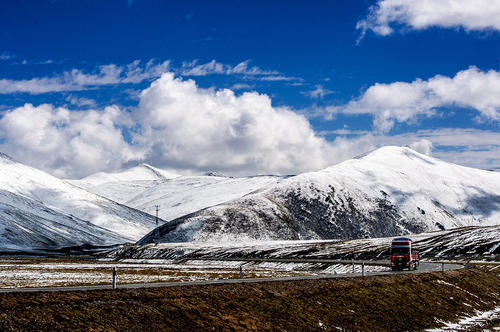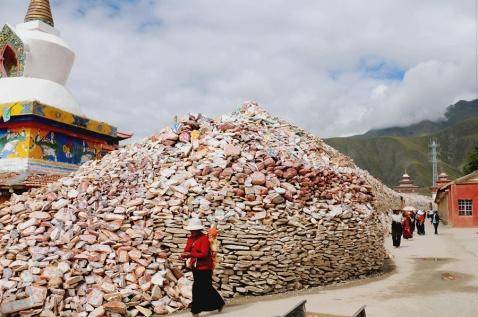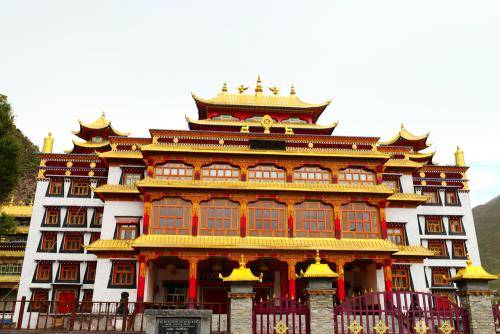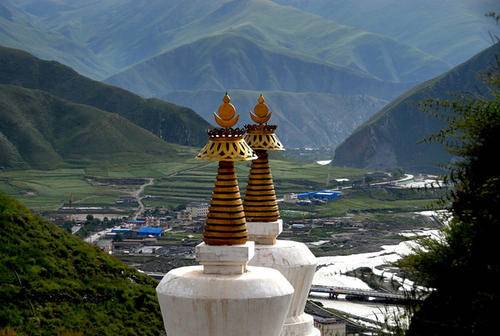Xinzai Mani Stone Mound
Located in Xinzai Village, Jiegu Town, Yushu, at an altitude of 3600 meters, here lies the 'world's largest blessing and wishing place'—Xinzai Mani Stone Mound! It is also the only stone mountain in the world built with text. Why? The mound is grand and its scale is considered the largest in the world. The number of individual stones reaches billions, and the total number of Mani stones now amounts to 2.5 billion. Coming here feels like stepping into a hall of stone scriptures. It is hard to imagine that this place was entirely formed by spontaneous actions of the people, where each time a believer prays or makes a wish, a few Mani stones are added, resulting in the current massive accumulation of Buddhist scriptures in this 'ocean'.
Labu Temple
A road leading to Labu Temple: it has the grandeur of the confluence of three rivers; the playful legend of the Sutra Stone; the mystery of the White Pagoda at the ferry; and the profound historical sense of the ancient Labu village. This is an excellent cultural road, and of course, an excellent self-driving route. This time, we set off to Labu Temple with a local self-driving team from Yushu, experiencing the true 'Need for Speed' on the plateau, with cliffs on the right and a great river on the left. This feeling of speeding on the road is simply exhilarating! It takes about 2 hours to travel from Yushu to Labu Temple. Although it is still under construction, the existing temple is already quite large in scale. The grandeur of the main hall is awe-inspiring and appears particularly magnificent under the sunlight. The mountain opposite the temple is covered with prayer flags, which emit a calming sound when the wind blows.
Du Kou White Pagoda
The Ga White Pagoda and the ancient ferry are located in Lada Village, Labu Township, Chengduo County, Qinghai Province, China. The legend of the Du Kou White Pagoda is the most fascinating to me. Besides its important position in religion, even the folk legends are quite interesting. It is said that a long time ago, a woman was collecting cow dung here when she suddenly felt an incredibly fragrant scent, saw a brilliant rainbow, and heard heavenly music. Gradually, a crystal pagoda emerged from the ground. In her panic, the woman covered it with her basket to prevent it from being damaged. But the next morning, she found that a huge Buddha pagoda had risen from the flat ground where she had placed her basket. The auspicious sign was evident.
Wencheng Princess Temple, also known as 'Jiasa Princess Temple', was first built during the Tang Dynasty and has a history of over 1300 years. It is an important cultural heritage site along the ancient Tang-Tibet route. From a distance, the fluttering prayer flags and the clear river flowing by give a sense of a feng shui treasure land, making one marvel at the wisdom of the ancients. Currently, photography is not allowed in the main hall of the Wencheng Princess Temple, but the murals and relics inside are indeed exquisite. The lectures by the master are very knowledgeable, making it a great place to sit down and listen to stories.
Jiegu Monastery
Jiegu Monastery is one of the most famous monasteries in the Tibetan areas of China. It boasts magnificent architecture, numerous monks, and a wealth of cultural relics. Many renowned Tibetan monks have studied here. Tibetans call it 'Jiegu Dunzhu Luo,' meaning 'Jiegu Righteous Island.' It is a Sakya sect monastery of the original Zha Wu tribe in the area. There are many stories about this monastery, and it is recommended to spend an afternoon here to listen to them. The canyon opposite the monastery is very beautiful, perfect for taking photos and enjoying a panoramic view of Yushu City.













